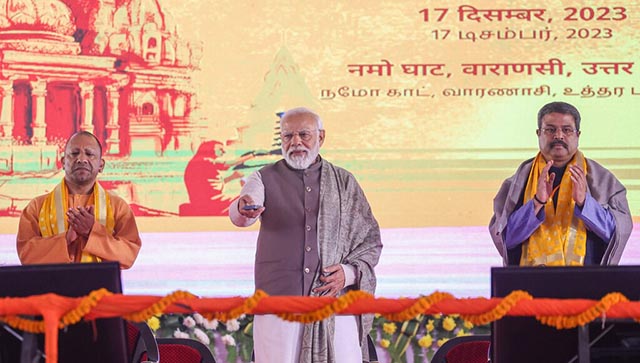Recently, at the Kashi Tamil Sangamam event in Varanasi, Prime Minister Narendra Modi’s speech was translated to Tamil from Hindi using a new Artificial Intelligence (AI) tool- Bhashini. As a National Public Digital Platform for languages, the tool has harnessed the power of AI to allow real time translation between two Indian languages. It also realises the objectives of the National Translation Mission of the Government of India, which sought to make knowledge accessible in the 22 official languages and establish the translation industry in India. A work-in-progress project, the tool has relied on crowdsourcing the linguistic knowledge of the ordinary citizens, by allowing them to contribute to Bhashini in their mother tongues. This process is named as Bhasha Daan – donation of language. The process ranges from translation of texts to validation of submission by other users. It has encouraged the citizens to participate in building the knowledge base of the tool, thus giving attention to several Indian languages. The Bhashini tool has a wide scope and in the wake of the AI revolution, it is important to discuss this. First, India’s unrecognised languages can be preserved through this project. Rajasthan has languages like Mewari, Marwari, Shekhavati, Hadauti etc. The languages are spoken by the hoi polloi but not used by the state in administration or education at any level. Thus, there is very little incentive that they can get by speaking their mother tongue. Further, this has led to a generation in urban Rajasthan which doesn’t speak their mother tongue and if this trend continues, India might compromise its linguistic diversity. Since Bhashini encourages the participation of the citizens speaking various languages, it can be used to preserve differing dialects, accommodate tribal languages, and promote the knowledge of lesser-known languages. Later on, the tool can be used to accommodate various unrecognised languages to offer crucial resources (like what to do in natural calamities) in a phased manner. Second, with the rapid development of the digital public infrastructure in India, it only makes sense that Bhashini is the next step in its creation. It can be used to provide access to payments and online services and creation of content, all in one’s own language. Live proceedings of the courts and legislative assemblies of any states can be translated. This will include India’s non-English speaking population in all these services. Third, this tool can help in boosting the economy through business and tourism. Imagine an Assamese businesswoman from Guwahati going to Tamil Nadu and successfully being able to negotiate a deal for her venture, without facing a language barrier. Or, a rare example, a techie from Gurugram being able to negotiate with Bengaluru’s auto-drivers in Kannada. This ease would bridge the North-South divide and the anti-Hindi sentiment that is prevalent in the pockets of south India. It will also be easy for international and domestic travellers to travel to a remote corner of India, which can boost the tourism sector and help India to grow its economy. The rise of Bhashini will dispel the linguistic chauvinism displayed by several political parties and politicians. On one hand, it will eliminate the use of a vehicular language between speakers of two different languages, by carrying out translations in real time. This will significantly reduce the push for Hindi and its adoption by non-Hindi states. On the other hand, it will also alleviate the fears of non-Hindi speakers, who feel that Hindi has been imposed on them time and again. Fourth, Bhashini can not only serve as a technological marvel but also as a cultural bridge, fostering a deeper understanding of India’s rich tapestry. The tool acts as a mediator in the exchange of cultural nuances, enabling a more profound appreciation of regional customs, traditions, and artistic expressions. A Gujarati listening to the melodious Rabindra Sangeet can understand the lyrics smoothly. Further, ragas of music can be identified using machine learning for Carnatic and Hindustani classical music. By facilitating accurate and nuanced translations, tools like Bhashini would help in cross-cultural interactions, contributing to the preservation and celebration of India’s diverse heritage. Fifth, as Bhashini unfolds its transformative potential, it prompts us to reflect on the broader implications of AI in shaping the future of communication and knowledge exchange. The project lays the groundwork for a new era where technology becomes an enabler of inclusivity rather than a source of division. In an age where AI is often viewed with scepticism, Bhashini stands as a testament to the positive impact technology can have on societal cohesion, breaking down linguistic barriers and fostering a sense of unity among diverse communities. The advent of Bhashini marks a significant milestone in India’s journey towards linguistic inclusivity and cultural understanding. As the tool continues to evolve, it not only addresses practical challenges in communication but also contributes to a vision of India where every language is acknowledged, respected, and given a platform to thrive. Harshil Mehta is an independent columnist who writes on international relations, and socio-political affairs; Bhavya Jha is a law graduate, interested in legal affairs, public policy and geopolitics. Views expressed in the above piece are personal and solely that of the author. They do not necessarily reflect Firstpost’s views. Read all the Latest News , Trending News , Cricket News , Bollywood News , India News and Entertainment News here. Follow us on Facebook, Twitter and Instagram.
The advent of Bhashini marks a significant milestone in India’s journey towards linguistic inclusivity and cultural understanding
Advertisement
End of Article


)

)
)
)
)
)
)
)
)



